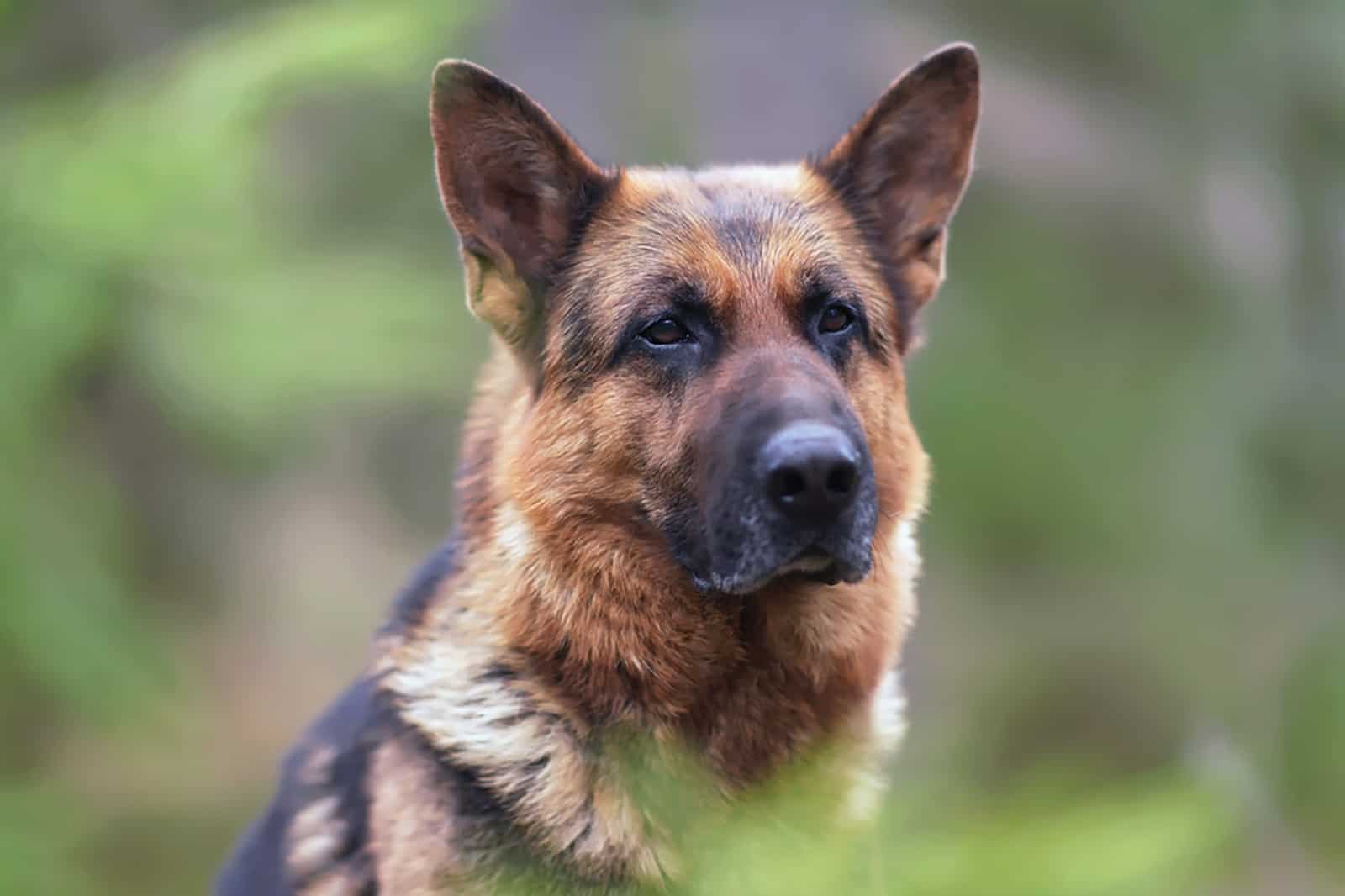If you’re wondering if there is a short-haired German shepherd, the answer is – Yes! A short-haired GSD is basically a standard German shepherd dog that you can see regularly on the street, on social media, or on TV.
A short-haired GSD is far more superior than the long haired version, given their agility, longer durability, and other physical advantages.
These pooches are commonly used as police dogs and military dogs, which gives them credit for being one of the greatest dog breeds in the world.
German Shepherd puppies are intelligent and loyal, and their activity level is high. The breed is definitely not for everyone as the dog requires long hours of work, training, and socialization. Sportsmen and people who spend a good part of the day working out are the perfect match for a GSD.
This is an AKC-recognized dog, and its overall price is not that cheap. Bear in mind that aside from their initial price, these working dogs require extra money for maintenance.
This includes regular vet exams, food and treats, grooming, poop bags, and other expenses, which can be overwhelming.
However, owning a German Shepherd puppy represents a lifetime of happiness as the dog is a true human companion and one of the most loyal dogs ever.
What Is A Short Haired German Shepherd?
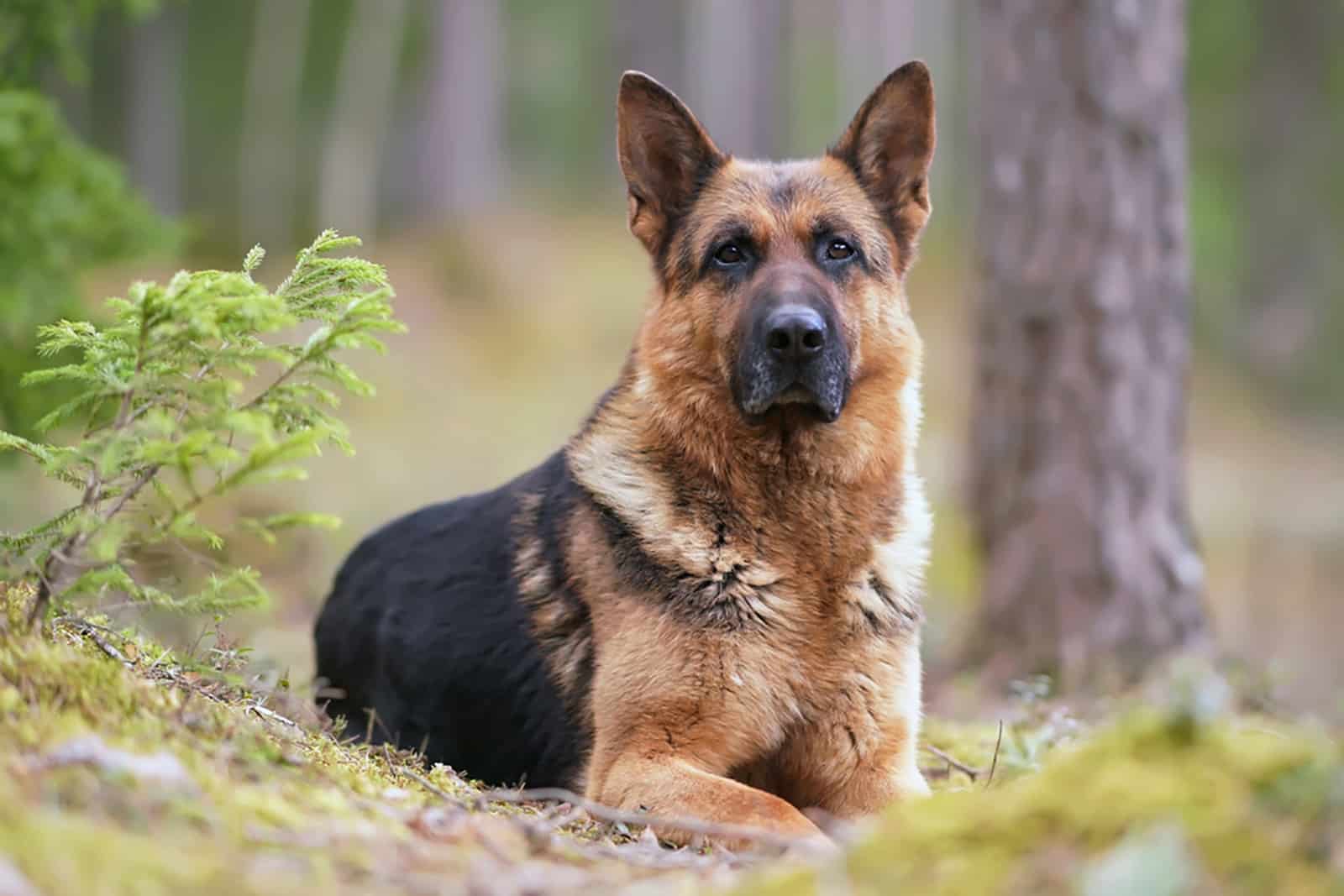
The American Kennel Club refers to the German Shepherd as being courageous, smart, and confident. It is 24 to 26 inches tall, and its average weight is somewhere between 60 and 90 pounds.
This is a purebred puppy, and it is highly favorable among breeders. There are a plethora of German Shepherd mixes that collect the best traits from their dog parent – the GSD.
The puppies have a double coat, which allows them high-functionality in the winter. The undercoat serves as an extra layer and maintains the GSDs temperature.
The canines’ coat is basically short. The most basic colors of their outer coat are: black and cream, black and tan, gray, black, sable, liver, and white.
The price of the puppy sometimes depends on its coat color, aside from other factors such as a breeder’s reputability, the fact that the puppy is not purchased, but adopted from a rescue, and many others.
German Shepherd VS. Belgian Malinois
Many people relate Belgian Malinois puppies with the German Shepherd breed. While they share many positive traits, we must know that the GSD breed still has many differences with respect to Malinois canines.
Most importantly, a German Shepherds’ appearance differs significantly. They have shorter legs and a longer coat. On the other hand, Belgian Malinois canines are slightly taller, and their long legs give them more agility.
Both of these dogs are military and police members, but the latter has better potential for physical acrobacies.
This refers to jumping and handling barriers more easily.
Military Belgian Malinois dogs are one of the strongest and most efficient military dogs on the planet.
On the other hand, both German Shepherds and Malinois have a strong and deadly jaw grip, which allows them to defend themselves from predators and enemies.
Both of these dogs are intelligent and easily trainable as both serve as police officers and complete complex tasks.
A Little Walk Through History
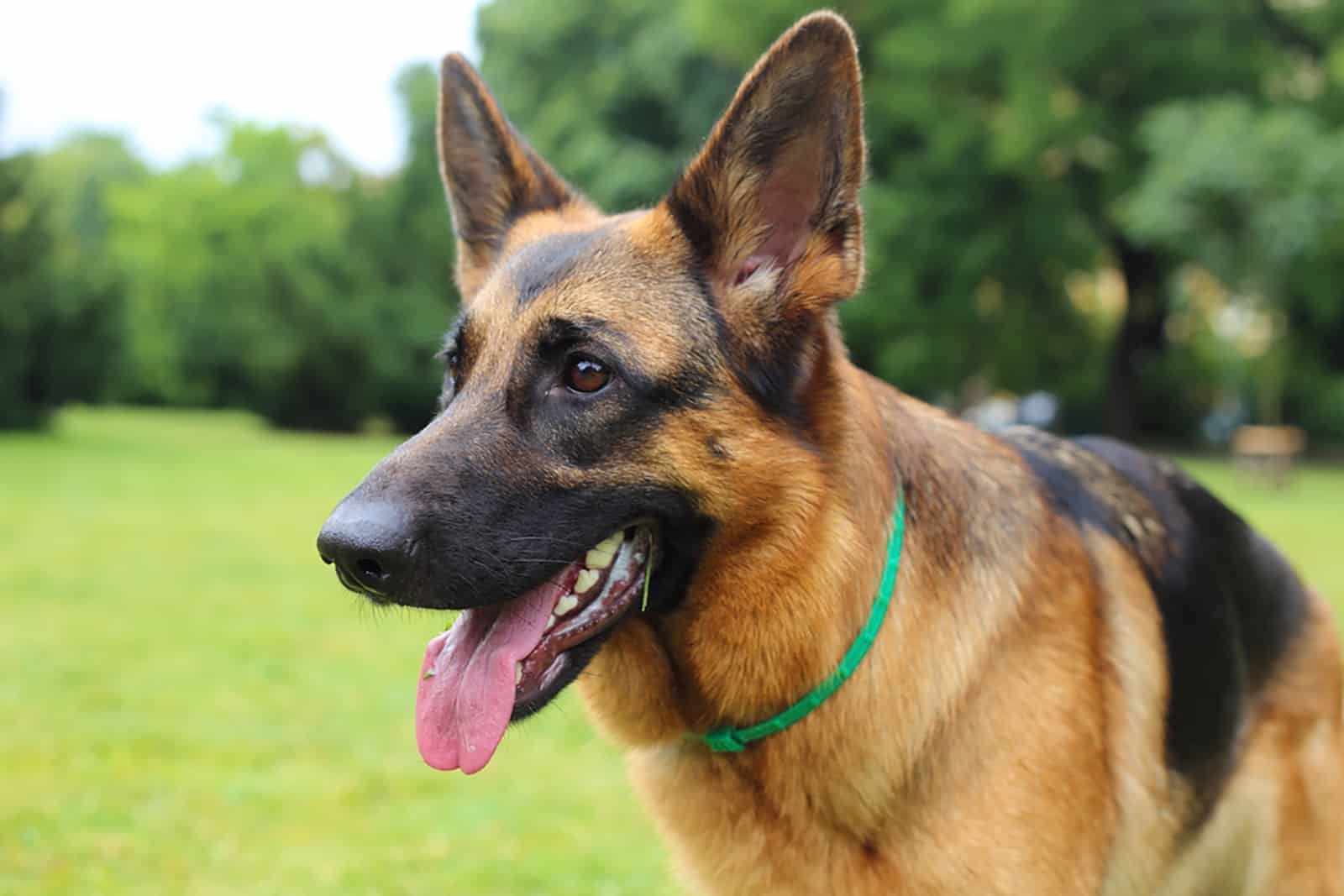
Max Von Stephanitz, the former German military officer from Dresden, was the first man to introduce the German Shepherd breed in the late 19th century. The breed was designed by using several German herding dogs.
It was initially used for work and herding before it actually became a military dog.
Ever since then, the breed has been commonly used for military and police purposes, alongside the Belgian Malinois, which shares the same values in terms of physical abilities.
Its intelligence and excellent ‘‘search and rescue’’ results have marked the breed as one of the most popular breeds in police academies worldwide.
Short-haired German Shepherds are nowadays widely used as family dogs, disability assistants, and sports dogs. The breed is one of the most common dogs in the world, together with the Labrador Retriever.
The fact that the puppy ‘‘retired’’ from overwhelming and hard-working police tasks left a gap in its daily household routine.
That’s why the German shepherd feeding chart should be properly monitored, as well as its overall health. Lack of activity may cause obesity and other health problems.
Loyalty, affection, and good behavior around family members make the puppy a true family pet and a human’s best friend.
Short Haired German Shepherd Appearance
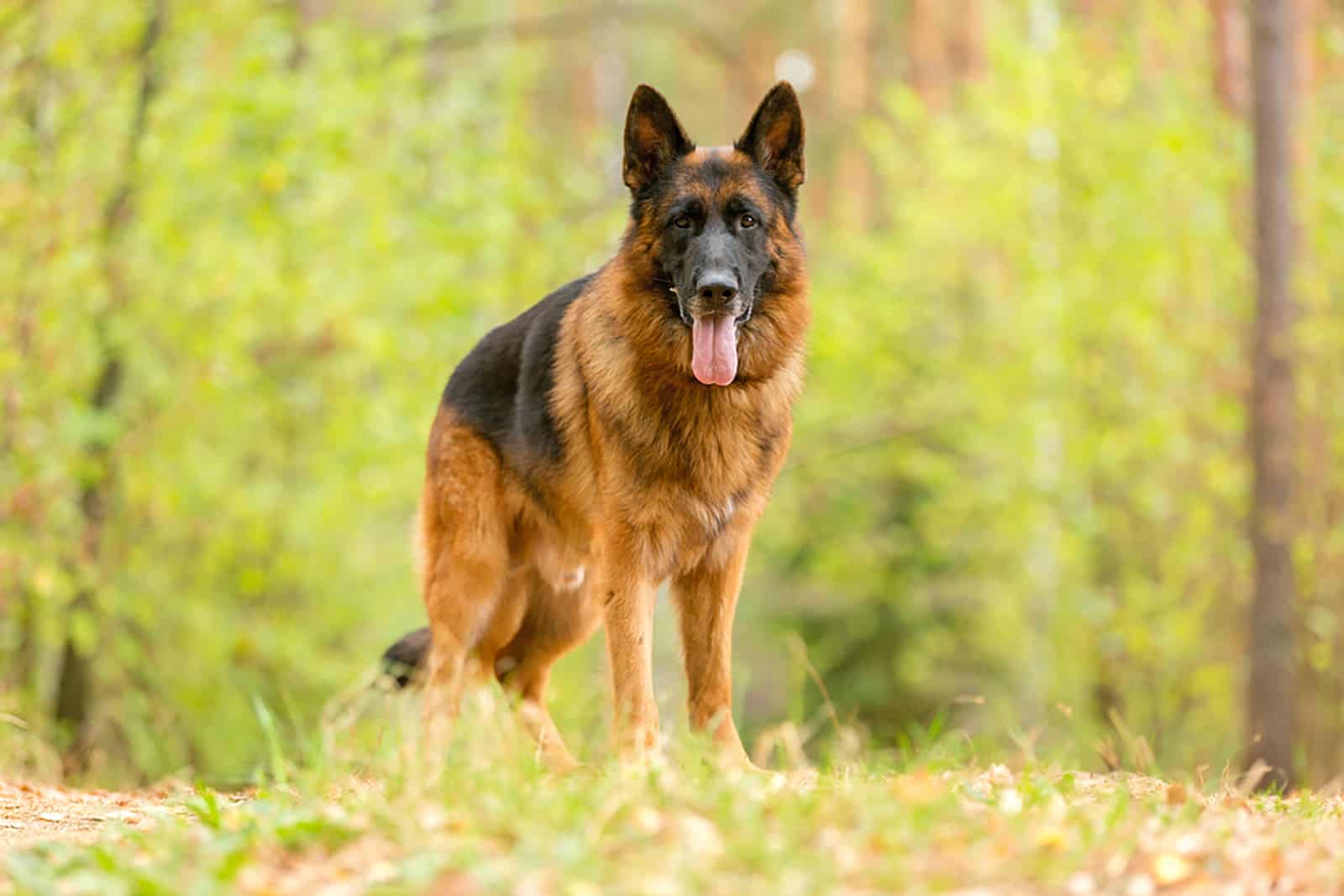
Reputable breeders describe the German Shepherd breed as agile and strong. It has a magnificent posture, which contributes to its overall appearance.
GS puppies take part in various dog shows related to conformation. Its short coat qualifies in the breed standard, which is not the case with long-haired German Shepherds.
The puppy is a watchdog by default, always on alert and ready to defend its owner. However, with the proper amount of early socialization, short haired German Shepherds will easily adapt to crowded groups, big families, and around children.
Aside from their long-haired counterparts, short-haired GSDs perform better on the field, and they make sportier dogs.
That’s why it is extremely important not to impact their activity needs negatively as the breed can become self-destructive in constantly closed spaces.
The German Shepherd growth chart should always be monitored as obesity does not do good for this breed.
GSD: A Large Breed
Short haired German Shepherd dogs don’t differ much from long-haired Shepherds when it comes to size. The latter appears bigger due to its furry coat, but the basics are almost the same.
Males are 24 to 26 inches tall, and weigh around 60 to 90 pounds. Females are slightly smaller. They are 22 to 24 inches tall, on average, and their weight does not exceed 70 pounds.
Purebred German Shepherds are categorized among the large dog breeds. However, we can’t say that the puppy has giant dog traits. It is rather moderately big, and it does not tolerate obesity.
Obesity decreases its physical performance, and disables the puppy from being as active as needed.
There are other versions of GSDs, like the miniature German Shepherd, but these are designer dogs that do not have pure GS traits in their appearance or in their behavior.
The size of the German Shepherd dog negatively correlates with its energy level, especially if we take into consideration that these puppies are fast and tireless!
Color
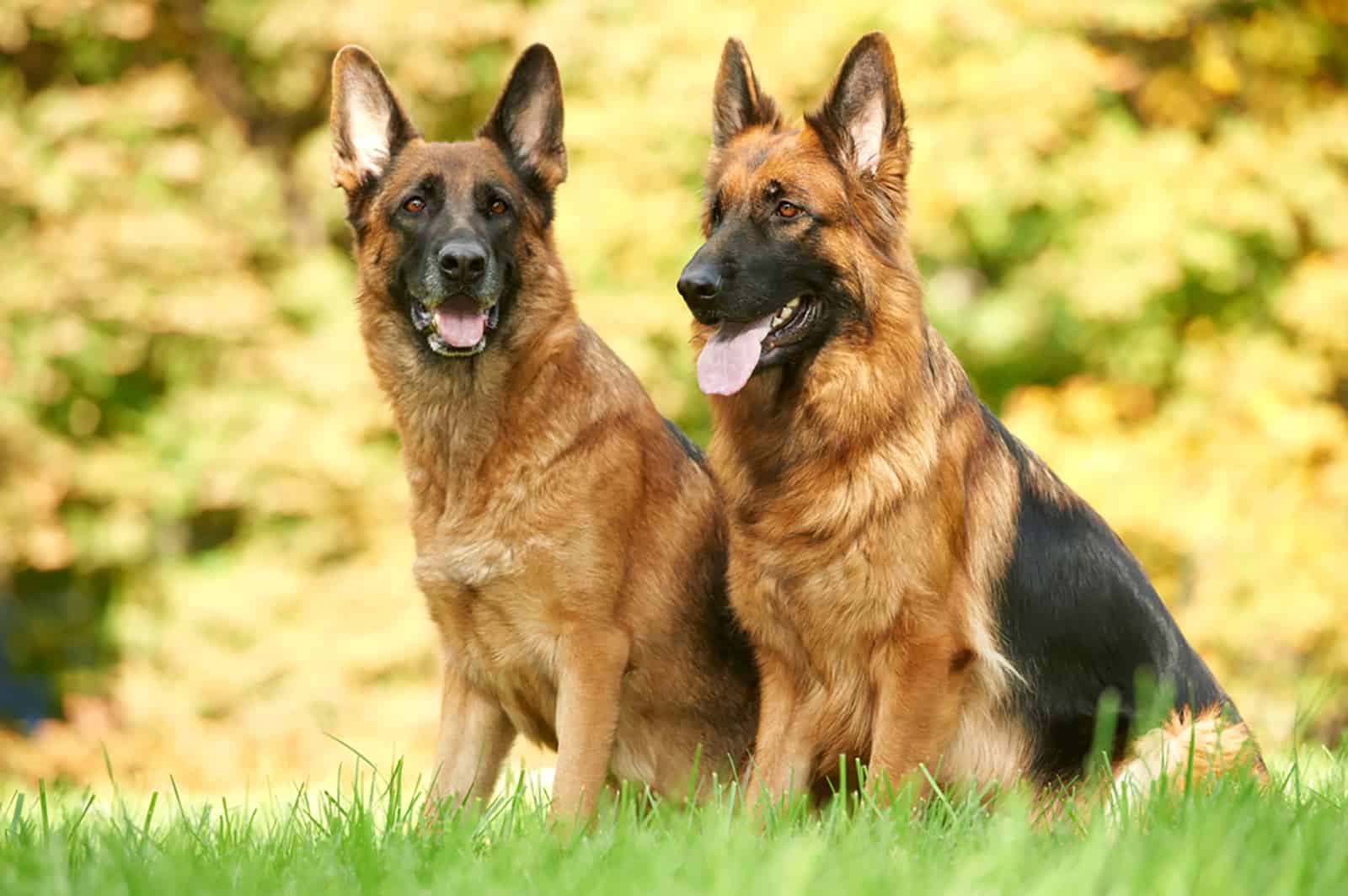
You probably watched Rin Tin Tin as a kid. Yes, you’re right! Black and cream is a trademark color in German Shepherds. It is widely represented and the most common color this puppy can have.
However, there are other interesting variants of coat that the German Shepherd can be found in. For instance, white German Shepherds, and black ones, are unique and less represented, but are still quite popular!
These solid-colored puppies have the same behavioral traits as the aforementioned puppy, but their look makes a different impression.
You probably think that no purebred German Shepherd puppy can have any other pigment than black and cream, but you’re wrong.
There are so many coat variants of this puppy, among which black and red, black and tan, liver, blue, gray, and white are classified as standard colors.
The German Shepherd price is determined by its coat color, and it has both gone up and down several hundred bucks, give or take.
However, the most important price determinants are: the breeder’s quality, the puppies’ trainability, its hair length, and the breeder’s location.
Do Short Haired German Shepherds Shed A Lot?
‘‘Do German Shepherds shed,’’ you ask? Well, you might not like the answer. Yes! Short haired German Shepherds shed, too!
They might have a tendency of shedding less than long-haired GSDs, given their coat length, but the puppy still needs grooming two to three times a week. This is by default a high-shedding breed, and it leaves trails everywhere it goes.
That’s why you need to think carefully about having one of these puppies inside your house. You will definitely have a lot of work to do, especially if your short-haired GSD loves spending time on the couch!
A puppy bed is a great option if your GS is an indoor dog. It provides comfort to your canine, and at the same time, the cleaning space is narrowed down.
Generally, German Shepherds that live indoors require crate training and socialization training at an early age.
Otherwise, you will have a long-term problem that cannot be solved within a week or two.
Short Haired German Shepherd Temperament
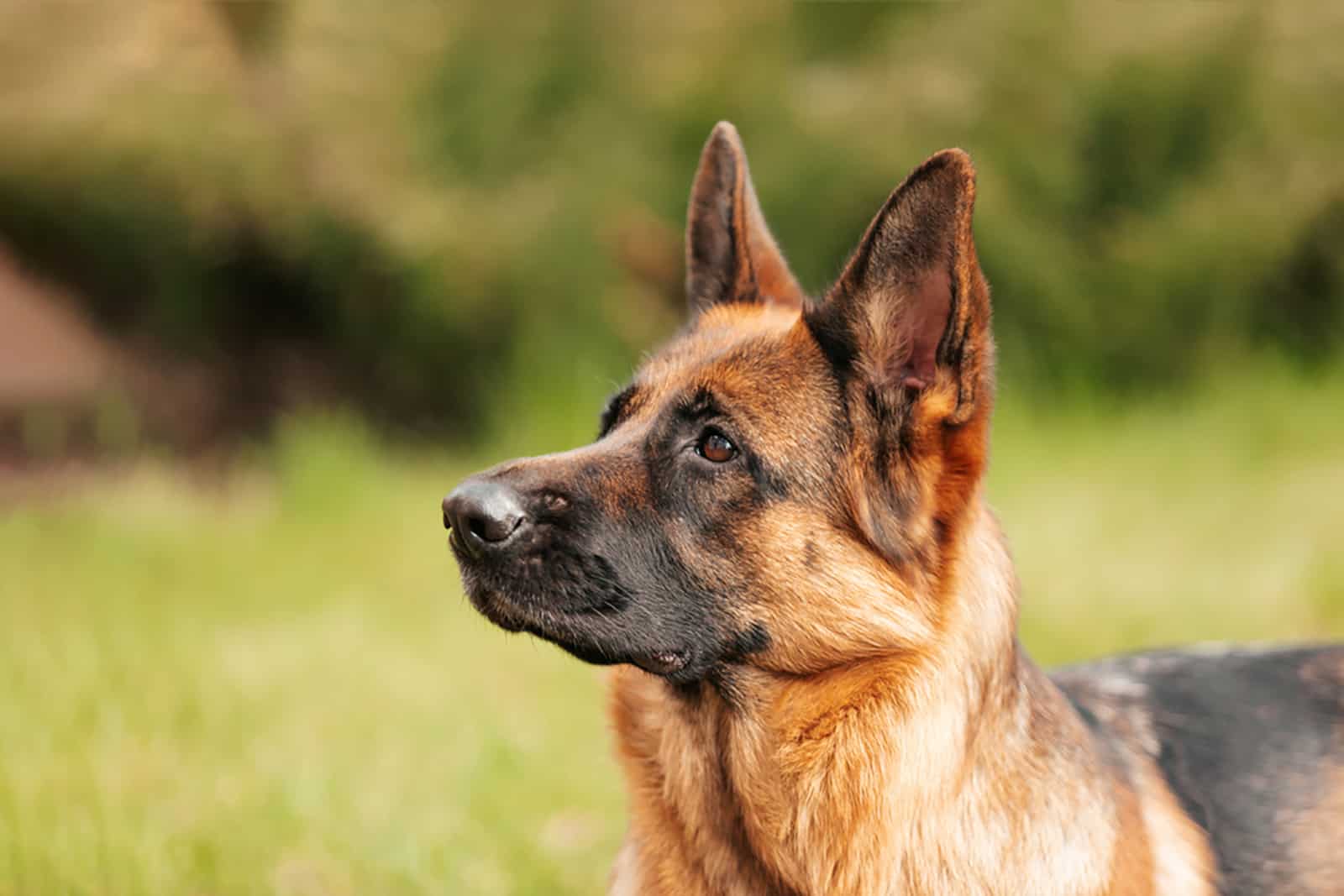
Are you a dog lover, but at the same time, you have an organized, punctual, and routine-oriented personality? Perfect! A short haired German Shepherds’ daily routine will positively correlate with yours!
These puppies are highly intelligent, and they love a routine and organization.
Being a military dog for so many years has shaped the breed’s character in a good way. They are obedient, well trained, and task-oriented canines.
In respect to their long-coat counterparts, short-haired GSDs seek more activity, and tend to be slightly independent.
The reason lies in the fact that long-haired GSDs basically have lower mobility potential, and they don’t enjoy being as exposed to outdoor activities as short-haired GSDs.
Short-haired GS canines are trained easily, and they love being challenged. That’s why the breed is favorable for crossbreeding with other strong, independent dog breeds.
For instance, the Belgian Malinois German Shepherd mix is quite popular among sportsmen and police officers.
GSD Behavior
Before letting a short haired German Shepherd puppy hang out with kids or other family members, make sure it is well-trained and that it is taught socialization.
This is crucial, taking into consideration the occasional unpredictability of GSDs. They can show signs of aggression around unknown people, but the main reason for that lies in an unfinished adaptation process.
They need an appropriate amount of time to adapt into new environments and get used to new people.
Canines that have gone through the process of early socialization do not have this problem, and they easily adapt to all kinds of situations.
Quality breeders of merit will make sure your puppy goes through an early neurological stimulation process before entering a new home.
Trained puppies will easily get along with all family members. Obedience training and socialization will make the question, ‘‘Are German Shepherds good with cats?’’, irrelevant in your household because they will indeed be good around all pets that you have.
German Shepherds are intelligent dogs that are ready to work, help, and entertain their owner. Having one in your home is a blessing as the dog not only makes a good companion, but shares your deepest emotions, too!
The breed has extremely good intuition, and it will detect all types of emotions that the dog parent shows. They will try to cheer you up, but they will also unselfishly share your sorrow.
Trainability
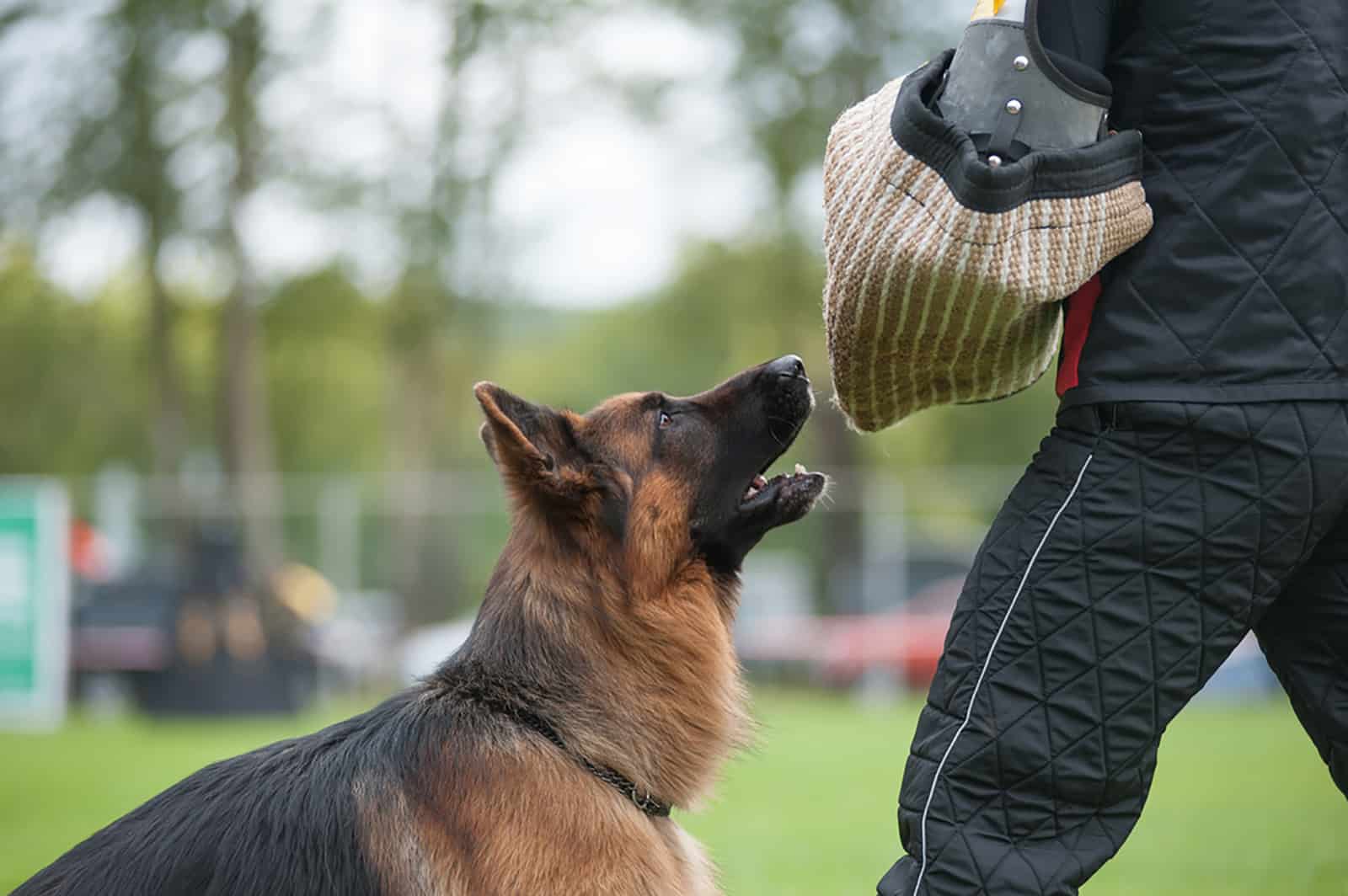
Always bear in mind that short haired German Shepherds are police and military dogs. This means they require a lot of training and plenty of space for fulfilling their activity needs.
All breeds require dog training in order to socialize and be obedient; however, GSD training really depends on your personal preferences. If you want your puppy to be a family dog that lives indoors, you need to focus on socialization training.
The tip is to teach socialization after a daily walk because that’s the time when puppies are mostly calm and ready to cuddle.
Dog treats are perfect for positive reinforcement in this regard.
Furthermore, if you’re an active person who prefers outside training, long walks, hikes, and running, then this canine won’t have any trouble accompanying you.
In fact, the German Shepherd breed prefers these sorts of activities as they are agile and love high-level activities.
However, the side effect of outside activities is your puppy’s coat getting dirty. You should frequently bathe a German Shepherd if you want your house to remain clean.
Lastly, we recommend developing a proper feeding chart for your GSD that goes along with its training. Never feed your puppy sooner than two hours prior to training as this will cause stomach torsion, severe pain and low mobility.
Short haired German Shepherds love routine, and they will act accordingly. Do not step away from regular activities as this will cause stress and anxiety to your puppy.
Dogs with an unstable daily routine will show inadequate behavior and won’t perform desirably.
Are Short Haired German Shepherds Aggressive?
One of the most common questions is: ‘‘Are short haired German Shepherds aggressive?’’ This is due to their vigilant nature and watchdog traits. But, the answer is: No! The breed is not aggressive if trained properly.
However, German Shepherds, as watchdogs, are put in the category of aggressive dog breeds basically because of the fact that they tend to roar, or howl when faced with potential threats.
This mostly relates to outside GSDs that serve as guardian dogs and don’t spend enough time around people.
There might be times when the breed shows extensive aggression, though. This is usually in two cases. First, they are aggressive towards unknown people who don’t know how to approach them, or simply show insecurity in the dog’s presence.
Dogs understand this behavior as hostile, and they act in a protective manner.
Second, German Shepherds can show signs of aggression if they are suffering from severe anxiety. The root of this health issue lies in separation from their owner.
The breed does not stand separation well, and it is not recommended to leave puppies on their own for more than a few hours.
Other reasons for anxiety can be found in the fact that some dog owners have a bully attitude towards their puppy and lack positive reinforcement.
This is where the German Shepherd’s response is directly proportional, as the breed perceives bullying as a potential threat.
Potential Health Issues Of Short Haired German Shepherds
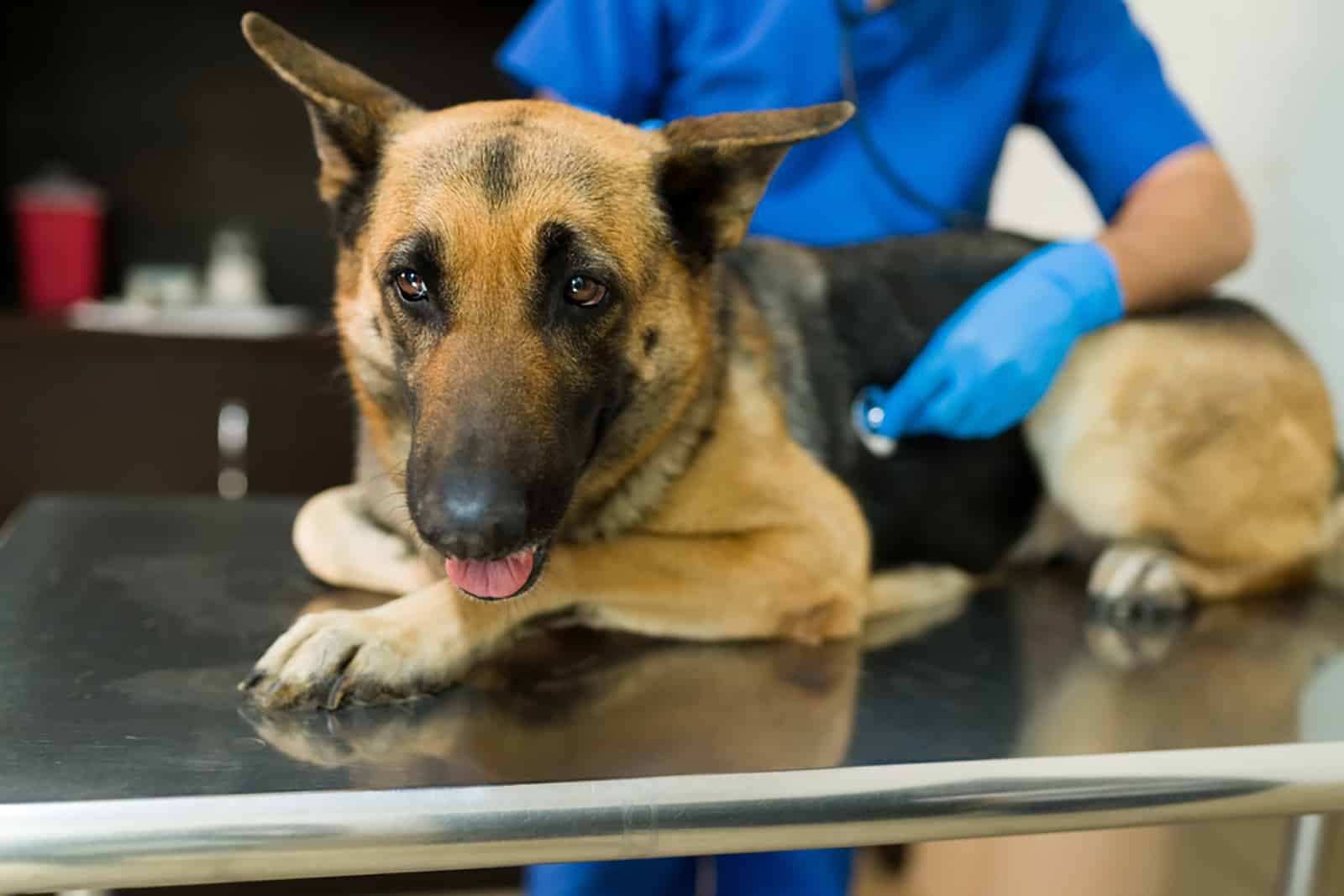
Generally, the GSD breed is healthy, and it does not have many health problems. The reason for that lies in the fact that short-haired GSs are active dogs, which contributes to their overall well-being.
They have a strong heart and an excellent body physique, and that’s why they are categorized among the healthiest dog breeds in the world.
However, as any other dog breed, these puppies meet several common health issues such as elbow dysplasia, hip dysplasia, gastric dilatation volvulus (commonly known as bloat), and diabetes.
These four are the most represented diseases in German Shepherds and, if not treated timely, can have severe repercussions.
Elbow Dysplasia
Elbow dysplasia in dogs is a common disease for large breeds, and it is mostly genetic. Small puppies inherit this condition from dog parents, and they have a lifetime of difficulties in regards to walking, running, and jumping.
Elbow dysplasia is a disease that affects the front legs, and it gives them a “C” shape. Puppies with this disease usually either have longer or shorter front legs, which causes stress and makes the bones fragile.
Typically, puppies at five months of age start showing elbow dysplasia symptoms. They are often expressed in lower mobility potential, the dogs’ inactivity, irregular walking, and refusing to do normal dog activities.
However, some dogs do not show symptoms despite being affected with this condition.
Puppies that face this condition should be monitored daily. They can’t become overweight, nor should you overwhelm them with extra activities. Elbow dysplasia can be controlled, but the best option for this issue is surgery.
Puppies recover quickly, and their overall posture is improved after surgery. Additionally, their breathing improves!
Hip Dysplasia
Another health issue that is common for large breeds is hip dysplasia. This disease manifests in joint malfunction, and it is mostly hereditary. Puppies show symptoms at an early age, starting at around two to three month of age.
The symptoms are manifested in low mobility, lowered hips, and a bunny walk. Puppies experience severe pain in this condition, and they usually avoid regular activities, such as running and jumping.
This condition cannot be prevented as it is inherited and genetic, but there are things that dog owners can do to control it.
You should prevent your puppy from being overweight as obesity negatively affects its posture and puts more pressure on its joints.
Also, do not overwhelm the dog with high-level exercises as its joints are not strong enough to provide enough resistance to these types of training.
Surgery can sometimes be an option, but a vet exam prior to that is mandatory. Also, take into consideration that it is not cheap, nor is it an overall treatment of dogs suffering from hip dysplasia.
Usually, the costs on a monthly basis are from $200 to $250.
Bloat
Bloat in dogs can be a deadly issue if not treated timely. Bloat (or medically known as gastric dilatation volvulus) is a condition of the stomach being filled with either gas or food. This is common for large breeds.
Bloat causes stomach stress, and puppies face severe pain. There are two things that affect bloat: unhealthy dog food, and poor feeding habits.
Unhealthy dog food usually refers to food with no sufficient healthy ingredients needed for the proper functioning of a dogs’ digestive system. A lack of fibers extracted from green vegetables increases the possibility of developing bloat.
You should stay away from unhealthy, refined carbs, as well as from the leftovers of your own food. Puppies need quality food in order to remain healthy.
Furthermore, develop a quality feeding chart and stick to a feeding routine! Divide the puppy’s daily meals into three basic ones, and try not to exceed the daily amount.
A treat here and there would probably not be a problem, but more than that is not recommended.
Diabetes
Just the same as humans, short haired German Shepherds can face diabetes. This is a progressive disease that affects the overall wellbeing of your puppy in the long run. It can either be hereditary or developed.
Canines that face diabetes should be fed with healthy dog food, so stay away from the worst dog food brands on the market!
Dogs facing diabetes can have occasional weight loss, a decrease in appetite, and cloudy eyes. Pooches also drink water excessively and face various urinary and skin infections.
Diabetes is a disease that can be controlled, and you should consider creating a strict and to-the-point feeding chart! Make sure the puppies get enough protein, fats, and healthy vegetables. Stay away from refined carbs and unhealthy treats.
Additionally, make sure your puppy gets enough exercise during the day. It improves the overall health of your dog, and keeps diabetes under control.
Frequently Asked Questions
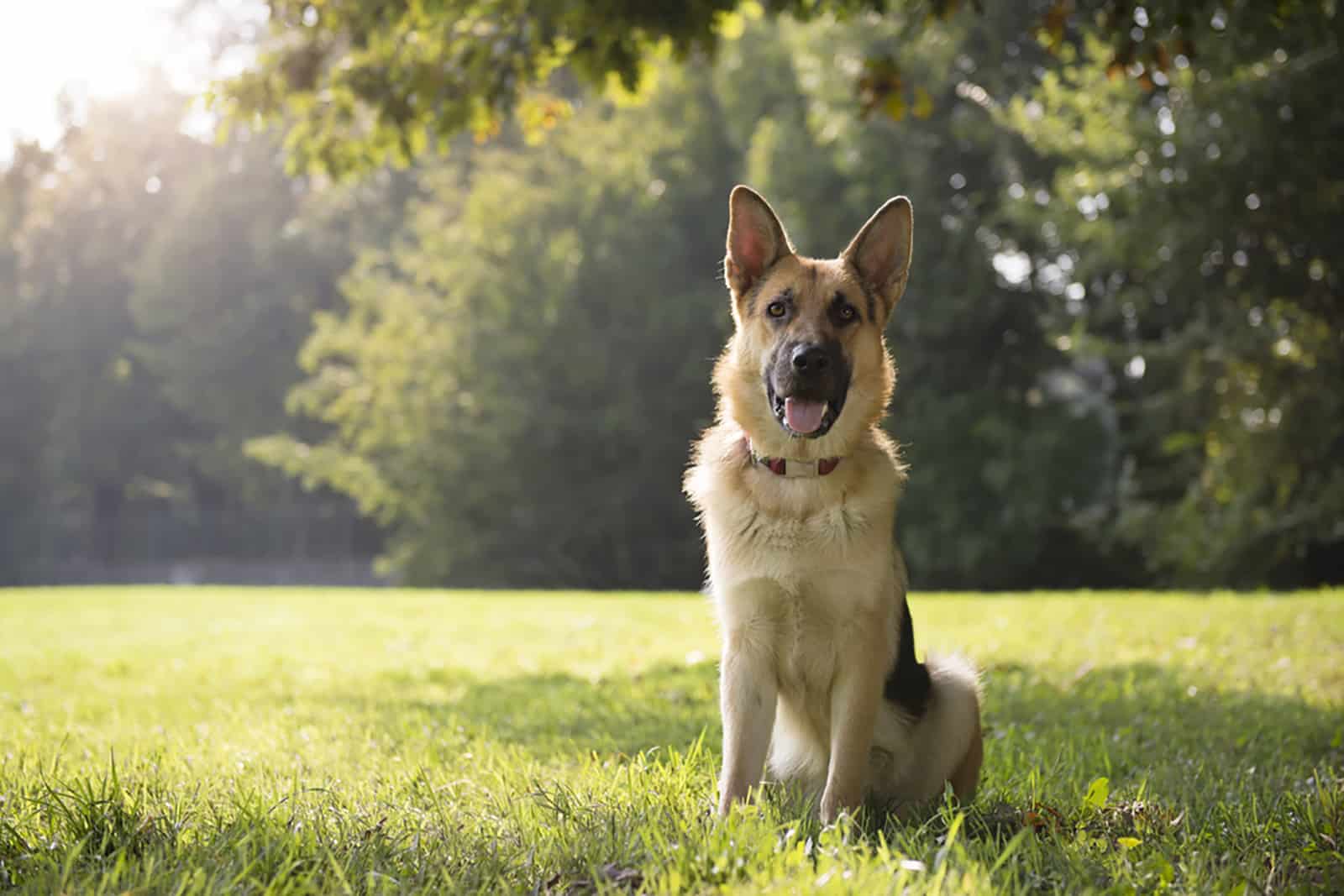
1. What Are The Differences Between Short Haired And Long Haired German Shepherds?
In the battle between long-haired German Shepherds vs. short-haired ones, there is no clear winner or loser. Both of these canines have advantages and disadvantages, and usually, it is up to the owner to decide which one suits him/her better.
Long-haired GSDs generally come across as bigger, given their medium-long hair. However, due to this coat type, their mobility level is lower than in short-haired GSDs.
Furthermore, long-haired canines are more prone to family life and moderate daily activities. However, this breed does not meet AKC breed standards.
On the other hand, short-haired GSDs are far more superior when it comes to agility, mobility, and overall physical potential.
These puppies are used in the military and the police as one of the best dogs based on physical performance.
However, both of these canines share almost the same behavioral traits. They are intelligent, loyal, and alert dogs that will do anything to protect their owner. They do not do well in closed spaces, and they can not stand separation well.
2. What Is A German Shepherd’s Lifespan?
Generally, German Shepherds live between 9 and 13 years. In respect to other dog breeds, this is not a long lifespan, given that some breeds can reach up to 16 to 17 years.
However, there are several determinants that affect the overall well-being of your GSD and improve its lifespan. The first is quality food. Always make sure you feed your canine with the best dog food for German Shepherds.
This maintains their health within the preferred standards, and it also improves their overall performance.
Also, make sure the puppy gets enough activity during the day. Lazy, couch potato German Shepherds are not happy, and their overall health is endangered.
Lastly, visit your veterinarian timely. Make sure the puppy does not suffer from hidden health issues, and that it gets timely treatments if it does.
Conclusion
Short haired German Shepherds are intelligent, strong, and determined puppies that fit perfectly into your active lifestyle. They are initially military and police dogs, but they can make excellent life companions in a family environment, too!
Always make sure your GSD buddy is socialized, obedience trained, and adapted to crowded places. This way, you will avoid unwanted consequences and make the puppy desirable for all types of personalities.
The German Shepherd is an excellent dog that is task-oriented and keen on making its owner happy. However, you should closely research the breed before purchasing in order to know all of its information.
Read more: 6 Top German Shepherd Breeders In Ohio: Find Your GSD Puppy!
